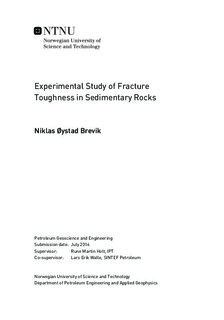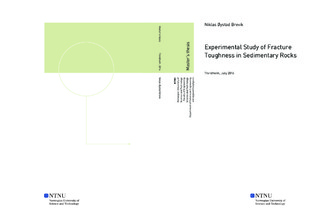| dc.description.abstract | This master thesis details the determination of mode I (tensile) fracture toughness, KIC, using the International Society of Rock Mechanics (ISRM) Chevron Bend (CB) method on three sedimentary rock types. Fracture toughness is an important parameter, describing the ability of the rock to avoid fracturing. It has three main purposes: a classification parameter for rock material, index of the rock fragmentation process and a material property used in models. Nonlinearity behavior was accounted for through the use of the plasticity factor. The primary motivation for these experiments is to improve on the ability to predict how hydraulic fractures occurs and where they go. Highly important to this is the fracture toughness parameter and its relevance for other parameters such as tensile strength, Brazilian strength etc.
Mode I fracture toughness determination was done on three rock types; Mons chalk, Castlegate sandstone and Mancos shale. The size effect was studied in Castlegate and Mons, using samples sizes of 38 and 50 mm diameter. The uncorrected fracture toughness showed a clear size effect, with increasing fracture toughness for increasing specimen size. Accounting for non-linearity, the fracture toughness for sandstone is independent of size, while the chalk still has a clear size effect. Mancos was used to investigate the anisotropy effect from bedding planes. The fracture toughness was seen to vary greatly with the inclination angle, but to what extent is not properly determined. Mixed mode fracturing is indicated by an increased plasticity factor for higher inclinations. Another finding was that the fractures were seen to follow the bedding planes whenever possible.
For the samples tested, the corrected fracture toughness is 0.153, 0.124, 0.221 and 0.231 MPa*m1/2, for Mons chalk of 50 mm diameter, Mons chalk of 38 mm diameter, Castlegate sandstone of 50 mm diameter and Castlegate sandstone of 38 mm diameter, respectively. Mancos shale varied from 0.370 to 1.287 MPa*m1/2. | |

